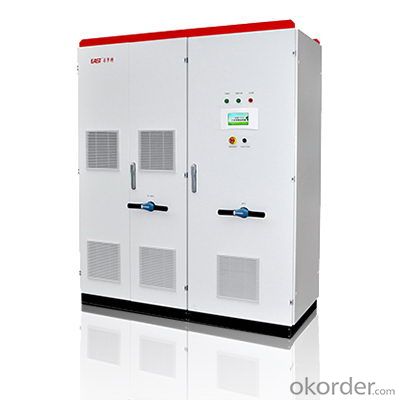Trina Solar Inverter for Residential and Small Commercial PV Installations
- Loading Port:
- China main port
- Payment Terms:
- TT or LC
- Min Order Qty:
- 10 carton
- Supply Capability:
- 20000 carton/month
OKorder Service Pledge
OKorder Financial Service
You Might Also Like
EA4KDL/EA4K6DL/EA5KDL/EA6KDL
EA4KDL / EA5KDL / EA6KDL is designed for residential and small commercial PV installations. This inverter has dual input section to process two strings with independent MPPT, high speed and precise MPPT algorithm for real-time power tracking and energy harvesting, as well as transformerless operation for high performance efficiencies of up to 97.5%. The wide input voltage range makes the inverter suitable to low power installations with reduced string size. This outdoor inverter has been designed as a completely sealed unit to withstand the harshest environmental conditions.
● Transformerless, maximum efficiency up to 97.5%
● Dual input sections with independent MPP tracking, allows optimal energy harvesting from two sub-arrays oriented in different directions
● Wide MPPT range, convenient for module configuration
● High speed and precise MPPT algorithm for real time power tracking and improved energy harvesting
● High reliability with full protective functions
● Ideal for outdoor installations
● Water-proof direct plug-in terminals
● Multilingual LCD, easy to operate
● Integrated multi-communication interfaces, easy to monitor
● TÜV, AS4777, CE, CQC certification
Specification/Type | EA4KDL | EA4K6DL | EA5KDL | EA6KDL |
Input (DC) | ||||
Max DC Power | 4400Wp | 5000Wp | 5500Wp | 6600Wp |
Max DC Voltage | 520V | 520V | 520V | 520V |
Recommend PV Array DC Voltage | 480V | 480V | 480V | 480V |
Full-load MPPT Voltage Range | 180-420V | 180-420V | 180-420V | 180-420V |
Number of Independent MPPT | 2 | 2 | 2 | 2 |
Max DC Current for Each MPPT | 12A | 14A | 15A | 18A |
Number of DC Inputs | 4(2 for each MPPT) | 4(2 for each MPPT) | 4(2 for each MPPT) | 4(2 for each MPPT) |
MPPT Efficiency (Static) | 99.5% | 99.5% | 99.5% | 99.5% |
Output (AC) | ||||
Nominal AC Power | 4000W | 4600W | 5000W | 6000W |
Nominal AC Voltage | 230Vac | 230Vac | 230Vac | 230Vac |
Nominal AC Current | 18A | 20A | 22A | 26A |
Nominal Frequency | 50Hz/60Hz | |||
Frequency Tolerance Range | 47.5-50.2Hz/57.5-60.2Hz | |||
Distortion (THD) | <3% (at rated power) | |||
Output DC Current Injection | <0.5% (at rated current) | |||
Power Factor (Cos phi) | >0.99 | |||
Number of Grid Phases | 1 | |||
System Parameters | ||||
Max Efficiency | 97.6% | 97.6% | 97.6% | 98.6% |
Euro Efficiency | 97.0% | 97.0% | 97.0% | 97.3% |
Night Consumption | 0W | |||
Topology | Transformerless | |||
Acoustic Noise Level | 50dB(A) | |||
Operation Temperature Range | -20℃~+60℃ | |||
Relative Humidity | 4~100%(no condensation) | |||
Protection Type | IP65 | |||
Above Sea Level | 1000m | |||
Structure Parameters | ||||
Dimensions(W×D×H) | 450×200×540mm | |||
Weight | 25kg | 25kg | 28kg | 28kg |
Others | ||||
Communication | RS485,USB(Optional),Ethernet (Optional) | |||
Display | Wide-screen LCD | |||
· Q. What's lifetime of a UPS ?
Most plug-in UPS are workable for at least five years. We'd advise you to change the batteries every three to four years. For larger equipment, we maintain equipment for twenty years old and still going strong.
· Q. How to maintain a UPS ?
There are three simple methods: Never overload your UPS, never connect any home electronic devices such as cooling fan to your UPS. This may cause malfunction of your UPS. Discharge the battery in a consistent interval, once a month or once two months. You can do this by turning on the UPS without connecting the mains.


- Q: How does a solar inverter handle voltage sags or swells in the grid?
- A solar inverter handles voltage sags or swells in the grid by continuously monitoring the voltage levels. When it detects a sag or swell, it adjusts its internal circuitry to regulate the output voltage accordingly. This ensures that the connected solar panels continue to operate within their optimal voltage range, minimizing any negative impact on the overall power generation system.
- Q: Can a solar inverter be installed outdoors?
- Yes, a solar inverter can be installed outdoors. However, it is important to ensure that the inverter is designed to be weatherproof and can withstand the elements. Additionally, proper ventilation and protection from direct sunlight should be considered when installing the inverter outdoors.
- Q: Can a solar inverter be used in areas with high levels of electromagnetic interference (EMI)?
- Yes, a solar inverter can be used in areas with high levels of electromagnetic interference (EMI). However, it is important to ensure that the inverter is designed and equipped to handle such conditions. Certain models of solar inverters are specifically designed to mitigate the effects of EMI and provide reliable performance even in challenging electromagnetic environments.
- Q: What is the difference between a transformerless inverter and a transformer-based inverter?
- A transformerless inverter and a transformer-based inverter differ primarily in their design and functionality. A transformerless inverter, as the name suggests, does not include a transformer in its circuitry. Instead, it uses advanced semiconductor components, such as insulated-gate bipolar transistors (IGBTs), to convert the direct current (DC) power from a source like solar panels into alternating current (AC) power for use in homes or businesses. The absence of a transformer allows for a more compact and lightweight design, making transformerless inverters ideal for space-constrained installations. However, due to the lack of galvanic isolation, transformerless inverters may have slightly less electrical safety compared to transformer-based inverters. On the other hand, a transformer-based inverter incorporates a transformer as an integral part of its circuitry. This transformer serves multiple purposes, including galvanic isolation, voltage step-up or step-down, and impedance matching. Galvanic isolation is particularly important as it provides a barrier between the input and output of the inverter, offering enhanced electrical safety and protection against electrical shocks. The presence of a transformer also helps to stabilize the output voltage, making transformer-based inverters more suitable for applications with sensitive electronics or where grid synchronization is critical. In summary, while transformerless inverters offer compactness and lightweight design, transformer-based inverters provide better electrical safety and stability. The choice between the two depends on the specific application requirements, space availability, and the level of electrical safety desired.
- Q: How does a solar inverter handle grid voltage variations?
- A solar inverter is equipped with a voltage regulation mechanism that allows it to handle grid voltage variations. It continuously monitors the grid voltage and adjusts the output voltage of the inverter accordingly to ensure a stable and consistent supply of electricity. This regulation mechanism helps to protect the inverter and the connected solar panels from any potential damage that may occur due to fluctuations in the grid voltage.
- Q: How does a solar inverter handle islanding detection?
- A solar inverter handles islanding detection by constantly monitoring the electrical grid. If it detects that the grid has been disconnected, it initiates a process to disconnect itself from the grid to prevent an islanding event. This is typically done through the use of advanced algorithms and protective mechanisms to ensure the safety and stability of the electrical system.
- Q: How does a solar inverter handle variations in solar irradiation?
- A solar inverter handles variations in solar irradiation by continuously monitoring the amount of sunlight received from the solar panels. It adjusts its power output accordingly to convert the maximum available DC power from the panels into AC power for use in the electrical grid or home. This dynamic response ensures that the inverter optimizes energy production even during changing weather conditions or fluctuations in solar irradiation.
- Q: How does a solar inverter handle voltage and frequency variations caused by load shedding?
- A solar inverter is designed to handle voltage and frequency variations caused by load shedding by having built-in mechanisms and control systems. When load shedding occurs and the grid voltage or frequency deviates from the normal range, the solar inverter detects these variations and adjusts its operation accordingly. To handle voltage variations, the solar inverter employs a voltage regulation system. It continuously monitors the grid voltage and compares it with the standard voltage level. If the grid voltage decreases or increases beyond the acceptable range, the inverter adjusts its internal voltage conversion process to maintain a stable output voltage. This ensures that the connected solar panels continue to generate power within the acceptable voltage limits, minimizing any negative effects due to voltage fluctuations. Similarly, for frequency variations caused by load shedding, the solar inverter has a frequency regulation mechanism. It monitors the grid frequency and compares it with the standard frequency level. In cases of frequency deviations, the inverter adjusts its internal synchronization process to match the grid frequency. This allows the inverter to synchronize with the grid and feed the generated solar power in a manner that is compatible with the grid's frequency. In addition to voltage and frequency regulation, solar inverters often have additional functionalities to enhance their ability to handle variations caused by load shedding. These may include features such as anti-islanding protection, which ensures that the solar system disconnects from the grid during a power outage to prevent safety hazards to utility workers attempting to restore power. Furthermore, some advanced inverters can also have energy storage capabilities, allowing them to store excess solar energy and provide uninterrupted power supply during load shedding events. Overall, solar inverters are specifically designed to handle voltage and frequency variations caused by load shedding. Through their regulation and control systems, they ensure that the solar power generated from the panels remains stable and compatible with the grid, providing a reliable and efficient power supply even during challenging grid conditions.
- Q: Can a solar inverter be used with a solar-powered disaster relief system?
- Yes, a solar inverter can be used with a solar-powered disaster relief system. A solar inverter is an essential component that converts the direct current (DC) generated by the solar panels into alternating current (AC), which is the form of electricity used in most appliances and the electrical grid. By using a solar inverter, the solar-powered disaster relief system can efficiently convert and utilize solar energy to power various devices and equipment needed in disaster relief efforts.
- Q: In a photovoltaic grid-connected project, the role of the inverter is to convert the voltage into AC 220V or 380V for the grid, since the transformer will raise the voltage again
- Spontaneous use is a way of grid, that is issued to the electricity, mainly their own family or internal use, the excess part of the power to the grid
Send your message to us
Trina Solar Inverter for Residential and Small Commercial PV Installations
- Loading Port:
- China main port
- Payment Terms:
- TT or LC
- Min Order Qty:
- 10 carton
- Supply Capability:
- 20000 carton/month
OKorder Service Pledge
OKorder Financial Service
Similar products
Hot products
Hot Searches
Related keywords
























